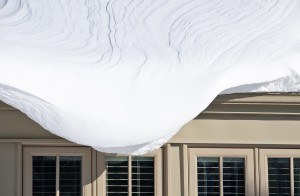

The location and type of roof and building impact whether a building is at risk for snow collapse. In addition, the thermal property and importance factor play a significant role as well, said Dan Mazzei, an engineering associate with Wallace Engineering, and Melvin Jeffers, an executive general adjuster with Engle Martin & Associates.
The two experts discussed snow collapse claims during a session on the subject held during the national Property Liability & Resource Bureau in Indianapolis, Ind.
 Mazzei explained the weight of wet snow, dry snow, and ice can vary significantly. As a result, each must be calculated based on their actual density.
Mazzei explained the weight of wet snow, dry snow, and ice can vary significantly. As a result, each must be calculated based on their actual density.
He outlined the estimated weight of each as:
Besides the weight and type of accumulation that can build up on a roof, the type of building is an important factor in a potential snow collapse. For example, a metal building is considered a building system, and according to Mazzei, all of the components in that system matter. If a piece is defective it can impact the integrity of the building, he said.
Mazzei emphasized that it’s important for claims and underwriting to know if the building was built to withstand snow load. The building’s original design drawings should outline the snow loads.
The age of building should be considered since adding additional equipment on a roof could impact the snow load, said Mazzei. Even a new HVAC system can affect snow load capacity.
The factors that affect snow load design include:
The location of a building is also important. Adjacent buildings built later can impact a lower roof snow load on a neighboring building. The location of surrounding buildings can impact a building’s snow loads.
Whether a roof is heated or not heated can impact the required snow load of a building. A building’s snow load capacity has to be “bumped up by 20 percent just for the reason that here no heat inside” Mazzei said.
In addition, a building’s importance factors are also when designating snow load capacity. For example, a hospital might be required to have a higher snow load capacity than a warehouse or agricultural building.
Unbalanced snow is another important factor. A building could have snow melt on one side of a roof while snow remains on the other side. This could push on opposing side causing collapse.
The USDA Forest Service and Missoula Technology & Development maintain a National Snow Load Information website. It contains link to each state’s snow load rules: http://www.fs.fed.us/t-d/snow_load/states.htm